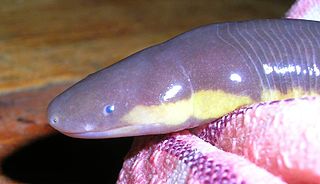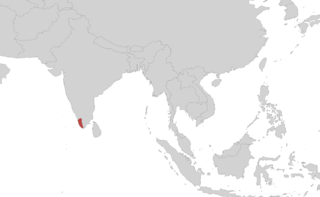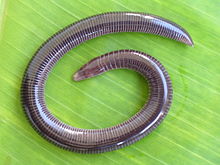
The Ichthyophiidae are the family of Asiatic tailed caecilians or fish caecilians found in South and Southeast Asia as well as southernmost China.

Ichthyophis beddomei is a species of caecilian in the family Ichthyophiidae. This species is distributed widely in the Western Ghats in southern India. The nominal species might be a composite of several cryptic species. It is also known as the yellow-striped caecilian, Beddome's caecilian, or Nilgherries caecilian.

Ichthyophis tricolor, the three-colored caecilian or Maddatorai caecilian, is an amphibian endemic to the Western Ghats, India. Its taxonomic status is unclear, including its relationship with Ichthyophis beddomei and the possibility of cryptic species.
Uraeotyphlus malabaricus is a species of caecilian in the family Ichthyophiidae. It is endemic to the Western Ghats of India and is known from its type locality, "Malabar" in Kerala, and from the Nilgiri mountains in Tamil Nadu. It is known with several common names: Malabar tailed caecilian, Nilgiris caecilian, Malabar caecilian, and white-lipped caecilian.

Uraeotyphlus menoni, also known as Menon's caecilian or Kerala caecilian, is a species of caecilian in the family Ichthyophiidae. It is endemic to the state of Kerala in the Western Ghats, India. The specific name menoni honours K. Ramunni Menon, collector of the holotype who later became the vice-chancellor of the University of Madras.

Uraeotyphlus oxyurus, also known as the red caecilian, sharp-nosed caecilian, dark-brown caecilian, pale-throated caecilian, or harp-tailed caecilian, is a species of caecilian in the family Ichthyophiidae. It is endemic to the Western Ghats in Kerala and Tamil Nadu, southern India.
Gegeneophis ramaswamii, common names Tenmalai caecilian, Tenmalai blind caecilian, Ramaswami's caecilian, and forest caecilian is a species of caecilian. It is endemic to the southern portion of the Western Ghats, India, and is recorded from Kerala and Tamil Nadu. The specific name ramaswamii honours L. S. Ramaswami, an Indian herpetologist.
Battersby's caecilian is a slender species of caecilian endemic to the Western Ghats, India. It has a flesh-coloured body, making it look very much like a large earthworm.
Indotyphlus maharashtraensis is a species of caecilians described in 2004 by scientists of Bombay Natural History Society and the Natural History Museum, London. It is only the second species of Indotyphlus known to science, and only known from its type locality near Humbarli village, Satara District, in the Western Ghats of Maharashtra, India. Common names Humbarli caecilian, Maharashtra caecilian, and Konkan tail-less caecilian have been coined for it.
Amolops chakrataensis, also known as the Dehradun stream frog or Chakrata torrent frog, is a species of frog endemic to India. It is only known from its type locality near Chakrata in Uttarakhand, near the Tiger Falls. It was described based on a single specimen collected in 1985. After being "lost" for 25 years, the species was rediscovered in 2011 at its type locality, reflecting the lack of field work in the area.

The Western Ghats in India are home to several species of caecilians (Gymnophiona). Caecilians are legless, burrowing amphibians which mostly live in leaf litter, loose soil, under rocks and decaying logs. They are also found in agricultural fields and only surface during the monsoon. The body is elongated and smooth with a slimy skin. The smaller caecilians superficially resemble earthworms while the larger ones are often mistaken for snakes. However, they can be told apart from earthworms by the presence of eyes, teeth and skeleton and from snakes by the lack of scales on skin. The eyes in caecilians are not well developed which is most likely to be because of their burrowing life style. They are considered as rare which is apparently due to their subterranean habits. To see them one has to search carefully and be at the right place and at the right time. There are few places where they are common, but, at least one species was reported to be abundant in agricultural fields in Kerala. The larger caecilians can resemble snakes, but their skin is smooth, not scaly.

Chthonerpeton exile is a species of caecilian in the family Typhlonectidae. It is endemic to Brazil, and only known from its imprecise type locality "Bahia". Only one specimen is known and now lost. The specific name exile, form Latin exilis, refers to the "relatively slender, delicate shape of the body and head." The common name Bahia caecilian has been coined for this species.
Oscaecilia hypereumeces is a species of caecilian in the family Caeciliidae. It appears to be endemic to Brazil and is only known from two specimens. The holotype was collected from Joinville in Santa Catarina, although there are some doubts whether this really is its correct origin. Another specimen originates from an unknown locality. Common name Joinville caecilian has been proposed for this species.

Anomaloglossus wothuja is a species of frog in the family Aromobatidae. It is endemic to Venezuela and is only known from its type locality, the base of Cerro Sipapo, in the Amazonas state. It appears to be endemic to the Cerro Cuao massif but might occur more widely in similar granitic areas.
Ichthyophis atricollaris, also known as the Long Bloee caecilian, is a species of caecilian in the family Ichthyophiidae. It is endemic to Sarawak, Borneo (Malaysia), and only known from its imprecise type locality, "Long Bloee, Boven Mahakkam, Borneo". The type series were collected during the Nieuwenhuis expedition to Borneo and were deposited at the Rijksmuseum van Natuurlijke Historie, Leiden.

Ichthyophis sumatranus, also known as the Sumatra caecilian, is a species of amphibian in the family Ichthyophiidae. It is endemic to Sumatra, Indonesia. It is known from western Sumatra, but many records lack precise location data and its exact range is poorly known.
Crotaphatrema tchabalmbaboensis is a species of caecilian in the family Scolecomorphidae, the tropical or African caecilians. It was discovered in 1997 on Mount Tchabal Mbabo in the Adamawa Plateau, western Cameroon, and described as a new species to science in 2000. Three specimens were collected at the type locality, and no individuals have been observed since.
Uraeotyphlus oommeni, sometimes known as the Oommen's caecilian, Oommen's Uraeotyphlus, or Bonnacord caecilian, is a species of caecilian in the family Ichthyophiidae. Within Uraeotyphlus, it belongs to the U. malabaricus group showing no obvious external differentiation between primary and higher-order annuli. This species is endemic to the Western Ghats and only known from its type locality, Bonaccord, Thiruvananthapuram district, southern Kerala. Very little is known about this species known only from a single specimen collected from an imprecise location.
Ichthyophis moustakius, the Manipur moustached caecilian, is a species of caecilian in the family Ichthyophiidae. It is endemic to Northeast India. This species exhibits broad lateral yellow stripes from the anterior part of its tail, along its mandibles, between its nares, as well as elsewhere. The animal can reach a length of 300 millimetres (12 in). Its head is somewhat U-shaped and fairly short; scales are absent on its collars. The species' name is derived from the Greek word moustakius, meaning "moustache", due to the yellow arched stripes it possesses.

Ichthyophis kodaguensis, also known as the Kodagu striped Ichthyophis, is a species of caecilian in the family Ichthyophiidae. It is endemic to the southern Western Ghats, India. All confirmed records are from southern Karnataka state, although it is also reported from adjacent Kerala.











